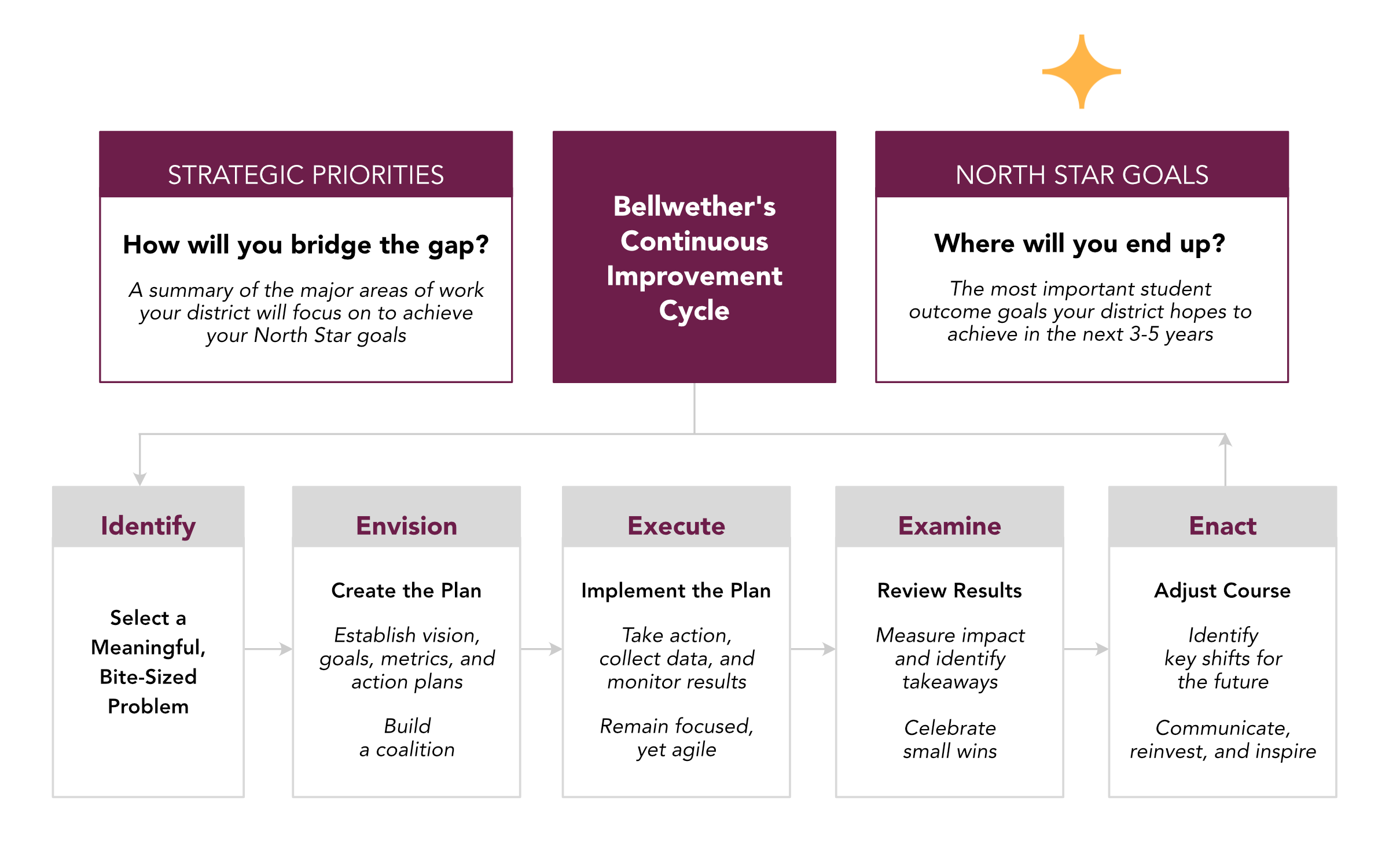A district’s strategic plan is only as effective as its implementation. But good implementation demands intentional supports and a scaffolded approach to continuous reflection, refinement, and improvement. These ingredients for strategic plan success, though challenging, are opportunities for district leaders to carve out disciplined time to revisit a plan, chart progress, and pivot to needed improvements — all while ensuring that it remains a living, evolving North Star.
Implementation with fidelity is hard work. And it can be difficult to know where to begin or how to chart progress in a strategic plan window that spans three to five years. Gains in student outcomes against the plan are a long game as is systemic districtwide change. Careful attention to inputs and leading indicators are critical. It’s hard work that requires attention, focus, and discipline to carve out the time and space needed amid competing priorities district leaders face on any given school day. Ultimately, it’s hard work that requires a bite-sized, ongoing approach to systematically break key steps down into manageable work streams.
Once a strategic plan is in place — guided by a transparent process that generates buy-in from the school community — district leaders can seed the ground for strong districtwide implementation in the following three ways.
Opportunity No. 1: Set up (or bolster) internal systems and structures, including a clear cadence of communication, to build alignment. Transparency among district leadership and stakeholders throughout a plan’s implementation phase is critical to maintain engagement and trust in the overall process. Often, leaders can leverage existing processes and functions among teams to (re)establish a clear and inclusive focus on plan goals and build capacity to drive the work forward.
One way to do this is through established meeting routines and structures that facilitate an ongoing dialogue about the work ahead, the plan’s rollout, and any needed course-correction along the way. District leaders can include cross-functional team representatives in these meetings who are already read into the planning process to focus action on implementation needs. Key considerations for successful and transparent communication structures include 1) determining the right frequency of stakeholder meetings aligned around a clear shared purpose, 2) defining short-term work streams to achieve long-term goals, and 3) establishing a recurring review cycle of early indicator data on a plan’s rollout. These tactics can ensure that teams are in constant conversation about a district’s strategic plan implementation, flag emergent issues, identify barriers to progress, and provide accountability for decision-making.
Opportunity No. 2: Build performance management systems to inform continuous improvement. A big challenge in strategic plan implementation is its multiyear nature. Many outcomes are long term and “lag” behind short-term or “lead” indicators of success. By focusing solely on lagging indicators (e.g., districtwide graduation rates), districts can miss leading indicators (e.g., attendance rates and course completion) to make just-in-time course-corrections to rightsize a plan’s implementation.
Performance management is critical in a plan’s successful implementation. By first identifying and aligning around a strategic plan’s lead indicators, district leaders and their teams can track short-term progress points that lead to long-term goals. Actions taken along the way should be predictive of success as measured by lagging indicators.
A helpful way to track this continuous improvement loop in a plan’s implementation is to develop a cadence and system for collecting, analyzing, and responding to lead measures that can help districts know where they are relative to lagging indicators or goals (Figure). Many districts develop a strategic plan “dashboard” as a tool to chart, monitor, and communicate progress toward key goals. An effective dashboard with key plan indicators mapped out in short- and long-term milestones enables districts to adjust courses of action as needed — similar to the Plan, Do, Check, and Act cycles deployed in many classrooms.

Opportunity No. 3: Break the strategic plan into one-year cycles and dedicate time for annual stepbacks, planning periods, and pivot points to establish a set of “big bets” that pave the way for improvement. It’s important to build dedicated time to revisit a strategic plan’s progress on an annual basis. Often, district leaders leverage the natural lead-up to existing budget cycles (e.g., winter or spring) or summer planning months ahead of an upcoming school year as an annual inflection point to step back and reflect on a strategic plan’s impact.
These conversations should be grounded in a set of strategic questions with a diverse group of district and school-based leaders designed to probe for opportunities and growth areas of a district’s progress toward strategic plan goals. Where do we double down? Where do we course-correct? What hypotheses did we have going into the school year, and which ones were (in)correct? What did we not fully anticipate that we can shift? What existing or needed resources will enable us to improve?
From this discussion, district leaders should identify two to three “big bets” that can facilitate or expedite improvement over the next school year toward its longer-term strategic plan goals. These can include budget and resource allocation shifts, increased and/or targeted communication to stakeholders to keep the “why” behind the plan top of mind, and department-level and school-specific plans led by principal supervisor strategic plan champions or “ambassadors” to ensure rollout is effectively implemented across the district, among others.
A multiyear, inclusive process coupled with focused implementation tactics that track leading and lagging indicators can ensure that a strategic plan shapes the everyday activities in a district rather than statically sit on a district’s website. And who better to shape it in a district’s school buildings and classrooms than principal supervisors.
Closing out the series: How investing in principal supervisors can translate a district’s strategic plan with fidelity into the everyday aspects of school and classroom culture.